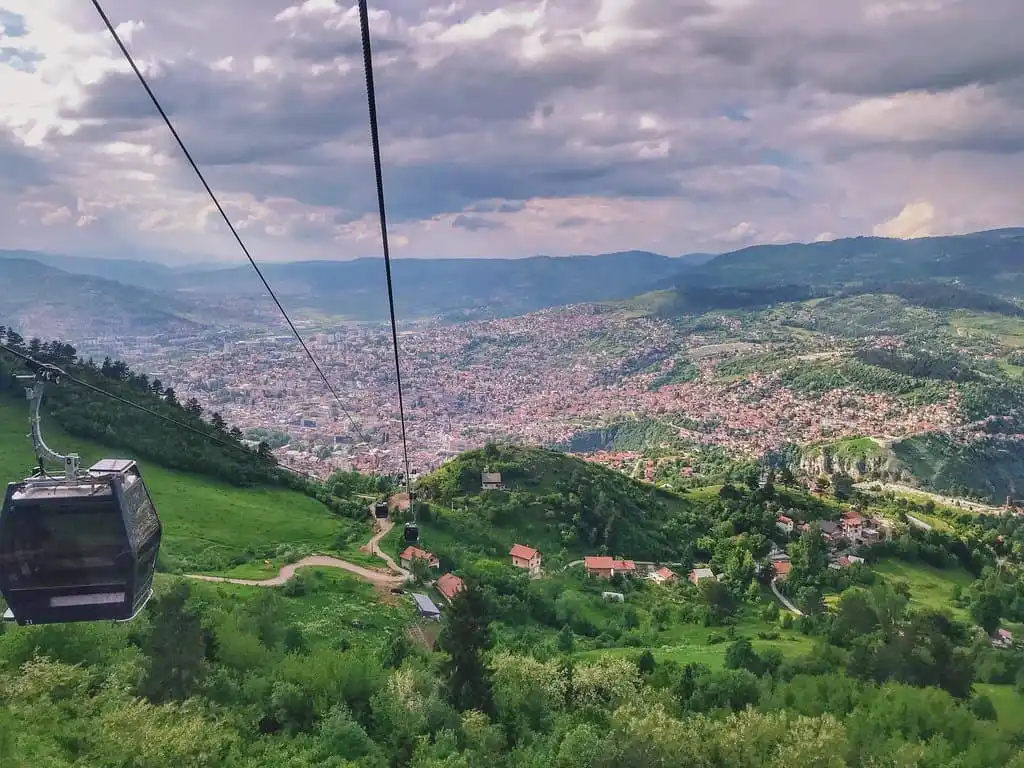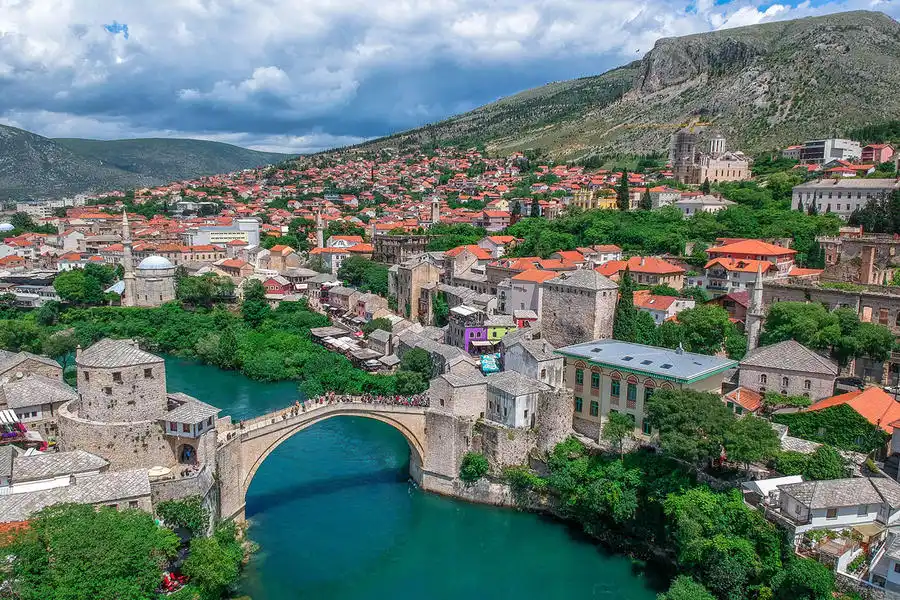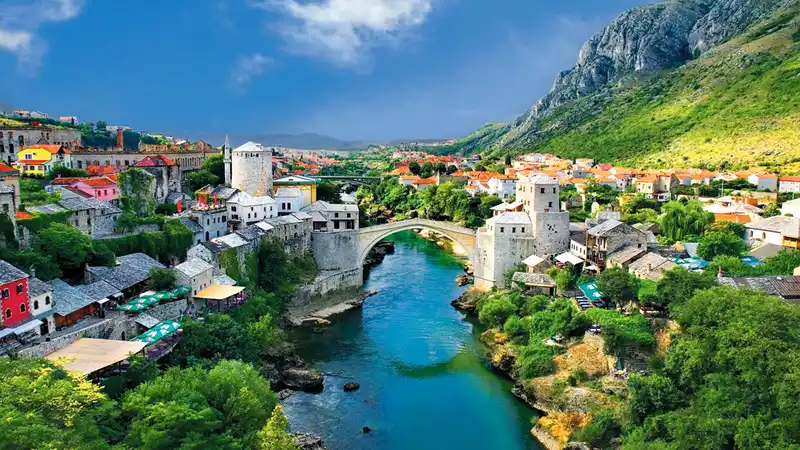This town is one of the most famous tourist destinations in Bosnia and Herzegovina. Tourism in Mostar offers a rich experience of a city with its cobblestone streets, ancient stone buildings, and the beautiful bridge spanning the enchanting Neretva River. This town feels like it has been taken straight out of the pages of a fairy tale.
History of Mostar
Mostar is located in the Herzegovina region. It began as a small town on a trade route between the Adriatic coast and central Bosnia.
Ottoman Rule
In 1468, the area came under Ottoman control. In 1566, by orders of Suleiman the Magnificent (the same person who transformed Constantinople into Istanbul), the wooden bridge was rebuilt in stone, standing for 427 years. This stone bridge was an architectural masterpiece at its construction and is said to be one of the most significant structures built during the Ottoman era.
Austro-Hungarian Rule
Austria-Hungary took control of the region in 1878 and ruled until 1918 when Bosnia and Herzegovina became part of Yugoslavia. In 1992, it declared independence from Yugoslavia. In 1994, the Old Bridge (Stari Most) was destroyed during the Croatian-Bosniak conflict.
Reconstruction
In the late 1990s, the Old Bridge was rebuilt and reopened in 2004, and in 2005, it was designated a UNESCO World Heritage Site.
Visiting Mostar
Tourism in Mostar can be enjoyed year-round, but the best months to visit are from April to October. Spring and autumn feature mild daytime temperatures, but there is a 50% chance of rain any day. Summer temperatures can rise to 36°C (97°F), though there is little chance of rain. Winter is the least favorable season due to cold and damp weather.
Peak Season - Tourism in Mostar
The peak tourist season occurs during the summer months. During this time, expect large crowds and high temperatures. The best months to visit are May, June, and September when the weather is pleasant, and the large crowds can be avoided. In April and October, there is a higher chance of rain, but Mostar is quieter with fewer tourists and lower accommodation costs.
Length of Stay in Mostar
Ideally, spend a full day with an overnight stay in Mostar. This gives you enough time to explore the town, get all the views you want of the Old Bridge, and even take a short trip to nearby sites. Staying overnight allows you to watch the sunset from either the riverbank or one of the riverside cafés. With more time, if you encounter some rain during your visit, the inclement weather won’t completely ruin your plans.
Day Trips to Mostar
Mostar is also a fantastic day trip destination from Split, Dubrovnik, or Sarajevo. From these cities, you can join a bus tour spending the middle of the day in Mostar, with transport in the morning and evening. This is perfect if you have limited time in your travel itinerary.
Quick Facts About Tourism in Mostar
Currency
The national currency is the Convertible Mark (BAM). For visitors coming from Croatia, some tourist places may accept euros, but markets and small shops will not.
Day Trip vs. Overnight Stay:
If you only want to explore Mostar, a long day trip from Croatia is enough to wander the old town, see the sights, and have a meal by the river. To see the Kravica Waterfalls and the Blagaj Tekke, I recommend spending a night in Mostar.
Swimwear Packing
Mostar is not close to the Adriatic coast, so most visitors don’t think to pack swimwear. However, on a warm summer day, sunbathing is a popular activity on the riverbanks with views of the Old Bridge.
Beginner's Guide - Tourism in Mostar
It includes the best places to visit, restaurants, accommodations, and more. You’ll find many ice cream shops along the pedestrian walkways.
Places to Visit - Tourism in Mostar
Old Bridge (Stari Most)
The Old Bridge is a symbol of Bosnia and Herzegovina. The Ottoman bridge rebuilt in the 16th century spans the Neretva River, linking both sides of Mostar’s old town. From a distance, the bridge looks like a scene from a medieval movie. It is a stunning sight. It is best to visit early in the morning for a quieter experience. Undoubtedly, the Old Bridge is the most important tourist attraction in the area. Walk across it, take selfies, and enjoy the views from the bridge while watching divers jump into the river.
Koski Mehmed Pasha Mosque
This small mosque is located on the edge of the old town and overlooks the river with stunning views of the Old Bridge from the minaret. Completed in 1618, it is the second-largest mosque in Mostar. This mosque was almost entirely destroyed during the Croatian-Bosniak conflict but was rebuilt later. Tourists can visit the mosque and climb the minaret for a small fee for a memorable view.
Kravica Waterfalls
This stunning waterfall park is a green oasis on the Trebižat River, reminiscent of Plitvice Lakes in Croatia but on a much smaller scale. Over 20 individual waterfalls cascade into the shimmering lake, some reaching heights of over 80 feet. The waterfalls can be visited year-round, but the best times to visit are during the summer months for swimming. Kravica is a 45-minute drive from Mostar and is open 24 hours a day (entry fees apply if you arrive during working hours). This picturesque site is quieter than the city of Mostar, offering a chance to swim if the weather is warm enough during your visit.
Kriva Cuprija Bridge
This arched stone bridge, looking like a miniature version of the Old Bridge, is located in the old town. It spans over a stream covered in dense greenery and is a very attractive place to visit. Built in 1558, this bridge is just a few minutes' walk from the Old Bridge, crossing a small stream that flows into the Neretva River.
Neretva River
Head down to the banks of the Neretva River for the best views of the Old Bridge. There are some protruding rocks along the water that provide excellent photo opportunities. Also, during warm afternoons, the riverbanks beneath the bridge are a popular sunbathing spot.
Old Bazaar (Bazar Kujundžiluk)
Near the river, there is a cobblestone corridor lined with cafés, restaurants, and small shops selling lanterns, jewelry, tea sets, and souvenirs. This market dates back to the 16th century.
Best Things to Do While Tourism in Bihac
The Old Town
There are many places to get the "best view" of the bridge, from the banks of the Neretva River to the minaret of the Koski Mehmed Pasha Mosque.
Before you step onto the bridge, there's something you should know: the surface of the bridge is slippery! There are raised grooves to help prevent slipping, but if you step on the smooth stones, you might find your feet slipping even with good shoes. Walk on the raised stones instead of the flat smooth surfaces.
The Old Town is small. With several cobbled alleys on either side of the Neretva River, it doesn't take long to explore the entire Old Town. These streets are lined with cafés and souvenir shops.
Crowds increase on the streets at midday as visitors come to Mostar on day trips, but at night, the crowds thin out, making it a real pleasure to stroll through these streets.
Old Bazaar (Bazar Kujundžiluk)
Located in the Old Town, east of the Old Bridge, this market is filled with souvenir shops and reminds visitors of the Grand Bazaar in Istanbul.
War Photo Exhibition
This small exhibition features about 50 photographs from the Croatian-Bosniak conflict. If you want to learn more about the war and its impact on Mostar, visiting this museum is worth it. The exhibition is located in the Helijja Tower, next to the Old Bridge.
If you wish to see more remnants from the wars of the 1990s, there are several sites such as the Sniper Tower, Tito's Palace, and buildings still riddled with bullet holes. Even in the Old Town, there are still traces of the war.
Tourism in Mostar - Outside the City
Blagaj Tekke
This 16th-century Ottoman Dervish monastery is built at the base of a steep cliff above the Buna River spring. The tekke is located in Blagaj, about 12 km southeast of Mostar, and takes approximately 25 minutes to drive there.


.png?locale=en)






.webp?locale=en)
.webp?locale=en)
.webp?locale=en)
